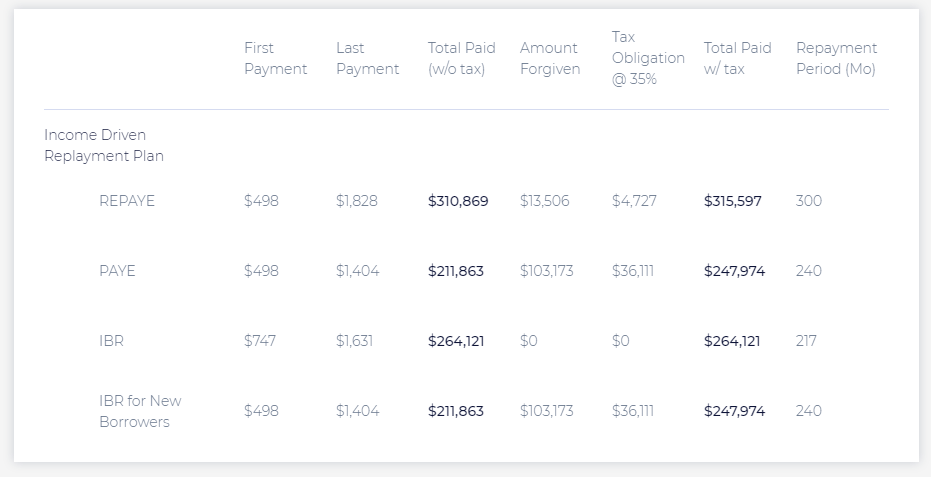Many people researching income driven repayment plans come across this word termed partial financial hardship. When you read the government’s definition you can get really confused. Therefore, I wrote this article to clear things up.
I answer the questions below in this article. However, before continuing I highly suggest reading our income driven repayment plan guide if you have not done so already.
- What is partial financial hardship?
- Is there an easy way to see if I qualify?
- What can my income go up to before I no longer qualify for partial financial hardship?
What Is Partial Financial Hardship?
Partial financial hardship is a formula used by the government to determine your eligibility for the Pay As You Earn (PAYE) and the Income-Based Repayment (IBR) plans.
Note: these plans are only applicable to Federal loans, not private loans. Therefore, if you are using one of these plans do not refinance your Federal loans.
The government’s approach to partial financial hardship is extremely confusing.
Therefore, I’m going to simplify it and walk you through the logic first. Then I’ll show you how to figure out if you’re eligible for PAYE or IBR using our free tool. Hint: the later is much (much) simpler than trying to do the math on your own.
The Logic Behind Partial Financial Hardship
At a high level, you will be eligible for PAYE or IBR if your required monthly payment on these plans is lower than what your required monthly payment would be if you were on a standard 10-year repayment plan. Therefore:
- The first thing to do is figure out what your required monthly payment would be under the 10 year standard repayment plan. If you are already in repayment, you need to figure out what this payment would have been when you first entered repayment.
- Then, you need to figure out what that required monthly payment is as a percentage of your discretionary income. Discretionary income is another weird calculation the government does.
For Old IBR, if the required monthly payment on a 10-year plan exceeds 15% of your discretionary income, then you qualify for partial financial hardship.
For PAYE and IBR For New Borrowers, if the required monthly payment on a 10-year plan exceeds 10% of your discretionary income, then you qualify for partial financial hardship.
If you file taxes jointly with a spouse, then this calculation includes your spouses’ Federal student loan payment and income. If you’d like to read more about filing jointly with your spouse then read our article titled: Student Loans Filing Separately or Jointly.
Confused yet?
Don’t worry. FitBUX made it easy to figure out using your FitBUX profile and our IDR calculator.
Is There An Easy Way To See If I Qualify?
If you want a quick answer to see if you qualify, yes. FitBUX did all the hard work for you.
In your FitBUX profile, click Tools from the left hand menu.
Then select our IDR calculator.

When you get to the screen showing the details for the 4 income driven repayment plans (pictured above), you will focus on PAYE and IBR.
These are the plans that partial financial hardship applies to. REPAYE doesn’t look at partial financial hardship, so you can ignore it here. If you’d like to read more about PAYE vs REPAYE, then check out this article.
Look at the first column labeled “First Payment”.
Now, you can simply compare the monthly payment for PAYE and IBR to the required monthly payment you would have to make on the 10 year standard plan.
If your PAYE or IBR payment is lower than the 10 year standard plan payment, you qualify from a partial financial hardship and are eligible for these IDR plan.
If not, you don’t qualify. It’s that simple!
What Can My Income Go Up To Before I No Longer Qualify For Partial Financial Hardship And Can No Longer Be On PAYE or IBR?
Once again, you can use our IDR calculator to answer this question. On the first screen of that calculator, you can change the adjusted gross income assumption then proceed to the chart comparing the income driven repayment plans.
Keep increasing the Adjusted Gross Income (AGI) upwards until the monthly payment under the column labeled “First Payment” equals the 10 year standard plan payment.
That is your maximum AGI. Anything higher and you’d no longer qualify for partial financial hardship. Thus, you would no longer qualify for PAYE or IBR. You can read more about AGI here to understand how it differs from your gross income
Summary
Partial financial hardship is a term used by the government to qualify student loan borrowers for IDR.
Its a confusing term but it doesn’t have to be.
To make things easy, be sure to become a member of FitBUX. Our expert student loan planners will make sure you know what to do and what plan is best for you!
